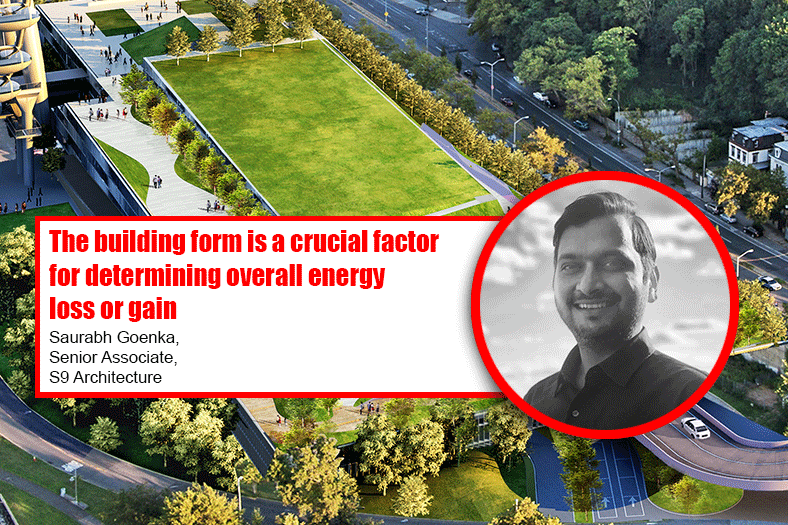The building form is a crucial factor for determining overall energy loss or gain

High-rise buildings designed with green atriums incorporated into the form can double up as outdoor public spaces while improving the building’s energy efficiency, says Saurabh Goenka, Senior Associate, S9 Architecture.
How does site selection and building orientation matter to energy efficiency in the pre-building phase? Can you illustrate with examples from your work?
Site selection is one of the first things to consider because an aptly located building can simultaneously tackle ecological impact, connectivity, orientation, energy efficiency and therefore, costs. Selecting a site that promotes urban infill and adaptive reuse encourages the use of existing infrastructure and utilities. Proximity to public transportation furthers walkability and reduces transportation distances, which in turn decreases the overall energy consumption.
Neptune and Sixth, one of my mixed-use development projects in a fairly suburban region of New York, focuses on developing near public transit and reducing the sprawl. While the base of the building is oriented orthogonally to respect the street grid, the tower itself has been oriented to capture sunlight for heating and daylighting. Hunters Point South is another carefully selected site along the New York waterfront, where our building design and orientation provides maximum solar exposure while also capturing breath-taking views of the waterfront.
Topography, latitude, and orientation are equally important as they determine the amount of solar radiation, daylight and prevailing winds that can be captured to reduce the burden on mechanical systems. Appropriate building orientation that allows for passive solar heating, cooling and daylighting can significantly reduce energy costs. For example, buildings should be oriented to maximize the southern exposure in cold climates, while elongated in the north-south direction in hotter regions. The potential impact of surrounding developments on solar and wind exposure must be considered as well.
What is the role that climate plays in attaining energy -efficiency, in which stage of the construction process does it need to be addressed?
The climate of the region helps identify the dominant energy loads that need the most attention. This plays an important role, especially in skin-load dominated buildings where most of the energy gain or loss occurs through the exterior skin. In hot and dry climates, it is not only the hot air entering the building that affects the indoor temperature but also heated building surfaces that conduct the heat to the interiors. This adds to the already dominant cooling loads and puts more pressure on the air conditioning system. In humid climates, the highly saturated air forces the air conditioning system to expend most of its energy trying to remove the latent heat. In cold and temperate climates, heat loss from the building skin is of prime concern as it adds to the overall heating loads.
A sensitive design approach using passive techniques can be adopted to tackle some of these negative impacts. Using high thermal mass materials on the exterior can counter the extreme day to night temperatures variations in hot climates by creating a thermal lag, which keeps the indoor temperature at comfortable levels. Encouraging natural ventilation can help remove the excess moisture in warm humid climates, hence reducing cooling loads. Compact building forms in cold climates can reduce the amount of exposed surface area, minimizing heat loss through the building envelope. Increased insulation can further improve energy efficiency.
Climate is a major determining factor in establishing overall energy efficiency goals, therefore an integrated design process with the early involvement of all experts from day one will be most beneficial. The team then functions as a single unit working towards the common goal of designing a sustainable energy-efficient building.
How does the total solar radiation gain of a building impact the energy efficiency desired in the long-term, how can this be offset?
Solar heat gain is directly related to the composition of building skin. Solar radiation heats the building’s horizontal and vertical surfaces, which in turn transfer that heat to the interiors through conduction. Buildings in countries closer to the equator like India, gain a majority of their heat from the roofs because of the high summer sun that directly heats the roof surfaces for a greater portion of the day. White roofs, green roofs and blue roofs are simple yet effective systems to reduce the impact and promote energy efficiency.
White roofs, by the nature of their colour and smooth texture, reflect solar radiation, thereby reducing the amount of heat transferred to the interiors. This solution can easily be implemented on existing buildings as well to substantially improve their energy performance. Green roofs not only reduce the amount of heat gain but also offer outdoor recreational opportunities. As an example, our design of the terminal building as part of the New York Wheel development aims at extending the surrounding natural environment into the buildings as they amalgamate with the landscape. Its green rooftops not only provide an extensive outdoor open space but also help reduce the heat island effect and thermal conduction, thus improving the building’s energy efficiency.
In the case of exterior walls, using materials with high thermal mass such as stone, concrete and bricks is of particular significance on south facades which gain the most amount of heat. A balance also needs to be maintained between daylighting needs and increased cooling needed to offset the effects of additional glazing. High-efficiency glazing with a low solar heat gain coefficient can help reduce this impact. Carefully positioned trees also reduce the amount of direct solar radiation that strikes the building surfaces. Such strategies can create a long-lasting positive effect on energy performance throughout the life cycle of a building.
How is the energy performance of a building affected by form, volume surface rate and frontal motions?
The building form is a crucial factor that determines the overall energy loss or gain. A direct relationship exists between the shape and energy efficiency of a building. The weaving facade of one of the projects I executed in New York not only offers a beautiful static composition while adding a three-dimensional aspect to the building grid but also provides window shading thus reducing the building’s energy utilization. High-rise buildings designed with green atriums incorporated into the form can double up as outdoor public spaces while improving the building’s energy efficiency.
In cold climates, a greater volume to surface area ratio reduces the overall energy loss while in hot climates, compact forms minimize the overall heat gain. Long and linear building forms oriented to capture prevailing winds are effective in humid regions. Dynamic facades that are capable of changing their form and orientation to automatically respond to their surroundings are considerably influential towards creating low energy buildings. Double skin facades and smart facades with daylight, temperature and humidity sensors can also optimize the building’s energy requirements. Smart windows with interactive shading devices and air vents can close during storms and open during favourable weather conditions. Automatically sliding window screens that adjust with the change in temperatures can further reduce the heat gain.
Leveraging the power of advanced energy simulation tools is of prime importance as well. There has been swift progress in our ability to replicate life-like situations for energy consumption analyses, daylight simulation and wind tunnel testing; all of which greatly benefit the energy performance.
What according to you are some of the renewable energy resources which can help a building in attaining energy-efficiency?
Identifying the renewable energy resource that is most suited to a particular building depends on its location and climatic conditions. That said, some renewable resources lend themselves to buildings more easily than others. Solar energy is one such source where tremendous technological progress has taken place. Given a site with sufficient solar exposure, we now have access to solutions that can be easily included in building design without sacrificing the aesthetic appeal. Building-integrated photovoltaic panels offer a creative way to design facades through thin film screens that can convert solar energy into electricity. Solar thermal energy can also be a simple and cost-effective strategy to satisfy a building’s heating and hot water demands. It can be implemented extensively to serve entire buildings and districts, or at a smaller scale such as using solar-powered lights, portable heaters and appliances.
Another renewable resource that can be beneficial and easy to implement is geothermal energy. Geothermal energy can usually be considered for efficient heating or cooling, regardless of the site location. The temperature beneath the earth’s surface, when compared to the outside temperature is cooler during summers and warmer during winters. The refrigerant lines running into the earth and back harness the heat or coolth of the earth’s core, consequently reducing the load on HVAC systems. Apart from the initial installation cost, this system can provide almost free heating and cooling year-round.
Cookie Consent
We use cookies to personalize your experience. By continuing to visit this website you agree to our Terms & Conditions, Privacy Policy and Cookie Policy.









